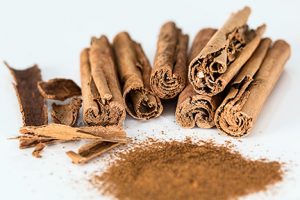 The benefits of cinnamon, love it or hate it are many!
The benefits of cinnamon, love it or hate it are many!
This ubiquitous kitchen spice is a powerhouse in your herbal first-aid kit as a home remedy.
Most of us will have cinnamon in our spice rack for flavouring our desserts and sweet goodness like carrot cakes and Christmas inspired recipes.
But, what if I told you that the same spice we use in our baking can also be used to balance our blood sugar!
What is Cinnamon?
Cinnamon is a bushy evergreen tree which grows up to 15 metres.
The cinnamon quills come from the dried inner bark of the tree. is a bushy evergreen tree which grows up to 15 metres. The cinnamon quills come from the dried inner bark of the tree.
There are hundreds of different types of cinnamon, but we commonly use four types interchangeably in our cooking.
- Ceylon cinnamon (Cinnamomum verum)is often considered to be “true cinnamon”.
- Saigon cinnamon
- Korintje
- Chinese cinnamon.
It can get a little confusing here as all of these are referred to as cassia cinnamon.
People will more often than not use Cassia cinnamon as it is cheaper than Ceylon cinnamon.
In baking, this is not really an issue as they have fairly similar tastes. However, if we’re looking at the medicinal use of cinnamon there are other factors to consider.
Whilst they all have overlapping benefits, cassia cinnamons have much higher levels of coumarins than Ceylon cinnamon.
Coumarins are known to be skin sensitising, anti-coagulant and in high levels, have a negative impact on your liver function(Battaglia 2005, Paper systematic review Ranasinghe et al).
Benefits of Cinnamon
Cinnamon has a number of different medicinal uses. Traditionally it’s used to treat:
- Respiratory problems
- Digestive complaints
- Gynaecological ailments
Researchers have found that cinnamon helps to:
- Lower blood sugar levels
- Lower “bad cholesterol”
- Help to lower blood pressure
- Improve wound Healing
- Anti-inflammatory
- Anti-oxidant
- Anti-microbial
We know that cinnamon is a potent anti-microbial.
Research has shown it to be effective against a wide range of bacteria, including some multi-drug resistant bacteria, pathogenic yeast and fungus.
Cinnamon bark essential oil has also been found to be quite effective in the treatment of head lice.
If you are pre-diabetic, the daily ingestion of 1 tsp of cinnamon and other lifestyle and dietary modifications are useful strategies to balance blood sugar.
However, it’s not an alternative to diabetic medications in those with diabetes.
Topically, cinnamon helps to increase wound healing and reduce pain and inflammation.
Just a few drops of cinnamon bark essential oil is a useful addition to a massage oil to help treat aches, pains and sporting injuries.
Cinnamon has been shown to be a potent antioxidant and may protect against some age-related diseases such as Alzheimer’s.
How Much Cinnamon to Use and How to Use It
There is some conflicting advice and evidence here. What’s clear is that a daily intake of Ceylon Cinnamon, around 4 grams or 1 tsp, is not harmful and may be of benefit to your health.
You can ingest this in several ways, perhaps try my Turmeric Chai Latte recipe below. You can have as a soothing drink if you have an upset stomach.
It can also be mixed it into your breakfast smoothie or sprinkle onto cereal.
Topically, you can make an ointment with Calendula and cinnamon essential oil to help with wound healing.
Try mixing some cinnamon with honey as a daily pick-me-up in the winter.
If you are pregnant, avoid using cinnamon, see here for more information.
The Bottom Line
Cinnamon is a tasty and cost-effective addition to your first-aid-kit.
Make the most of this herb, there are not many other medicinal plants that can lay claim to both tasting great and being of benefit in a number of ailments.
Just remember to use Ceylon cinnamon and stick to around 1 tsp a day.
It’s best used in the cold winter months as it’s a warming herb that will help to boost your immune system.
Mixing cinnamon and honey is a winning combination.
Turmeric Chai Latte Recipe
- 2 cups of milk of any type of milk (almond, pecan, coconut and dairy etc)
- 1 tsp Turmeric
- ½ tsp Cinnamon
- 1 tsp honey (pref raw) or maple syrup to taste
- Pinch of black pepper (this increases the absorption)
- Very small piece of fresh, peeled ginger root (you can use ¼ tsp ginger powder instead
- Blend all the ingredients in a high-speed blender until completely smooth.
- Pour into a small pan and heat for 3-5 minutes over medium heat. Don’t boil, just heat till warm.
- Drink straight away.
Sources
Austin, D. E. (1998). The Green Pharmacy. Economic Botany, 52(3), 266-266.
Battaglia, S. (2003). The complete guide to aromatherapy. International Centre of Holistic Aromatherapy.
betterhealth.vic.gov.au/health/conditionsandtreatments/metabolic-syndrome
Mills, S., & Bone, K. (2000). Principles and practice of phytotherapy. Modern herbal medicine. Churchill Livingstone.
organiclifestylemagazine.com/cinnamon-ceylon-vs-cassia-health-benefits-and-other-interesting-facts
Ranasinghe, P., Pigera, S., Premakumara, G. S., Galappaththy, P., Constantine, G. R., & Katulanda, P. (2013). Medicinal properties of ‘true’cinnamon (Cinnamomum zeylanicum): a systematic review. BMC complementary and alternative medicine, 13(1), 1.

Hi there, we set up our blog with the help of a business called That Helpful Chick
https://thathelpfulchick.com/contact-form/
They are an online company offering complete business solutions for people who don’t have much in the way of internet/blogging/marketing experience. Price wise I found them to be very competitive (which is great because I don’t have unlimited funds to throw around)
Feel free to keep us in the loop with your experience.
Good Luck!